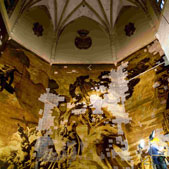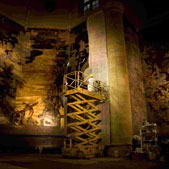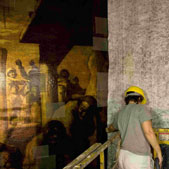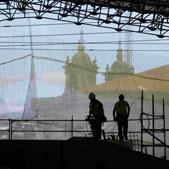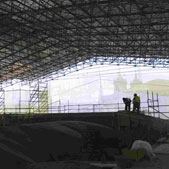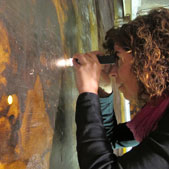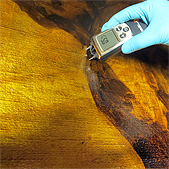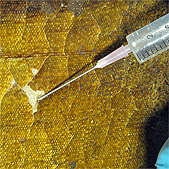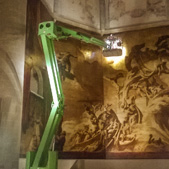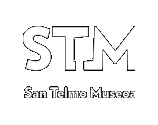Restoration of the Sert canvases

"Sert’s Anatomy" is the title of the conservation and restoration project for the Sert canvases located in the church of the San Telmo Museum.
This title has been chosen because anatomy is a science that studies the characteristics, location and inter-relations of those elements that form part of a body, and this is the line of work we have tried to pursue with Sert’s work.
These canvases have experienced serious conservation problems since the outset. Together with the natural ageing of its constituent elements, these are canvases which are attached to the walls; therefore, all the problems deriving from the constructive features of the building itself have had a direct effect on them.
For this reason and following a great deal of intervention throughout their history, it has proven necessary to set a comprehensive project in motion that simultaneously takes all agents into consideration that contribute to wear and tear – both those of an internal and an external nature.
The Sert’s Anatomy project thus came into being not as a specific restoration project, but rather, as an entire analytical process that got underway in 2007 and which will continue for life via a scheduled preventive conservation programme.
We can draw a distinction between several phases in this process, some of which have already been completed:
1 first phase
A first prior preventive protection phase of an urgent nature deemed necessary to minimize any risk.
This protective work was carried out by the company Artelan S.L in 2007, and involved consolidating specific areas with the greatest problems, thus avoiding the risk of loss of paint. Much of this consolidation work has had to be continued up to the present time, and can still be seen on the surface of the paint in the form of small attached pieces of paper.
2 Second phase
A second study and intervention phase regarding those agents that contribute to external wear and tear.
Of all the external agents, attention should be especially drawn to the problems with damp existing in the building, owing to their seriousness. These problems have since the outset been the main factor causing damage to the canvases.
In this respect, among the noteworthy courses of action that have been taken to rectify this problem, we should highlight the intervention carried out during the restoration work on the building done under the supervision of Nieto Sobejano, such as: the removal of the marble skirting board that used to run around the entire church and contributed towards a rise in damp from the subsoil, the replacement of the old church roof with a new one, and the restoration of external masonry in order to minimize water leakage through the perimeter walls.
3 Third phase
A third phase involving stabilization and checking the effectiveness of the measures taken and their link to the conditions under which the place is used. Thus, data about temperature and relative humidity of the church have been gathered over two years using environmental monitoring probes, while also maintaining preventive protection in the areas at most risk.
4 Fourth phase
Lastly, the fourth phase is the study and intervention of those internal agents that contribute to wear and tear, which was completed via a long-term preventive Conservation Plan.
Ártyco is the company that carried out the work, between May and October 2013.
5 Fifth phase
Preventive conservation and maintenance of canvases. After the canvas restoration came to an end in 2014, a preventive conservation for life programme was put into place as the best way of guaranteeing the monitoring of the state of the canvases and optimising financial resources, avoiding large investments in new restoration campaigns.
Until today, among other things, the hygrometric data has been shown to have improved the levels of humidity, and isolated interventions have been carried out to fix the polychromatic strata and to recover the transparency of glazes and varnishes.
Fifth phase
WEB HEADER:
PAGE FOOTER:
Auxiliary menu:
San Telmo Museoa. 2024 copyright ©
HELP WHIT SURFING:
